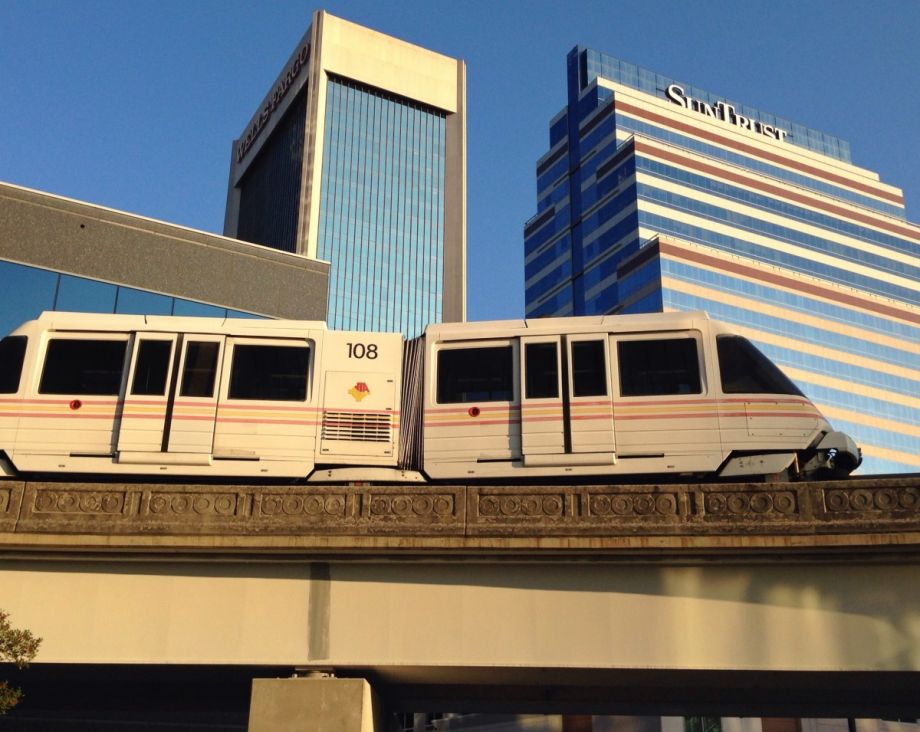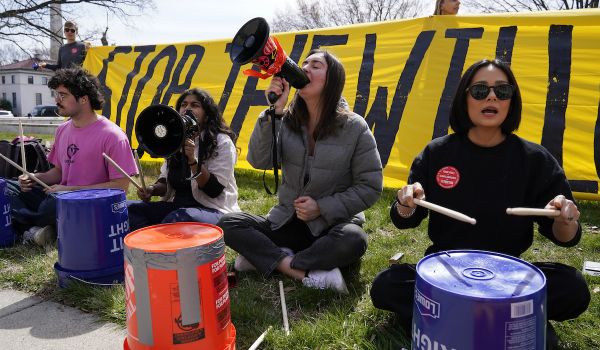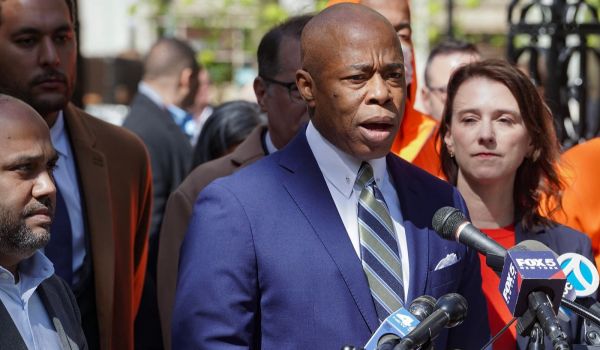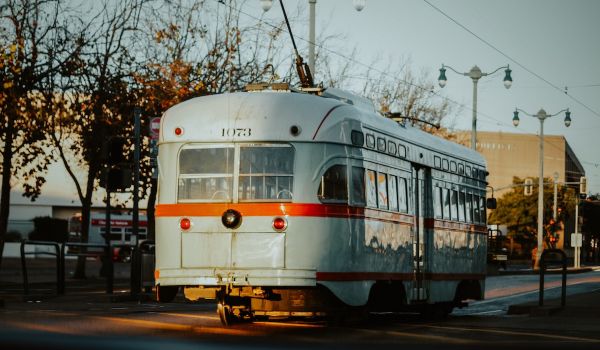Like bell-bottoms, leisure suits, platform shoes and Brutalist architecture, downtown people movers have come to be regarded by many as period pieces, another of those tragic fashions of the 1970s that might best be relegated to the dustbin of history. Of the four such systems built in the United States from the late 1970s to the early 1980s, only one could be considered an unqualified success: Miami’s. And that’s because the rapid transit system for which it was to serve as a collector/distributor also got built too. The system in Morgantown, West Virginia, is a qualified success, as the on-demand service is generally considered the first working example of personal rapid transit.
That leaves the other two systems, both orphans of grander plans that were never realized. Detroit’s people mover gamely soldiers on while private investors place their hopes for the future on a modern streetcar line. And then there’s the Jacksonville Skyway, a double anomaly in that it not only never got connected to a proposed light-rail system but it also employs a monorail technology that is no longer being made or supported. As the Skyway’s railcars are reaching the end of their useful lives, the question of whether or how to equip it for the future has become a live one in Florida’s largest city.
Both the Jacksonville Transit Authority and local residents seem to agree that the Skyway should be modernized and maybe even extended so that it actually goes somewhere useful. What remains unsettled is how that should be done.
Enter Ennis Davis and Robert Mann, two of the co-editors/publishers of Metro Jacksonville, a blog devoted to news and opinion for the city with a special focus on development and planning issues. In its nine years of existence, the blog has championed food trucks as a vital element in a vibrant urban streetscape, fought ill-thought-out road-building proposals and torpedoed the JTA’s plan to turn a major downtown thoroughfare into a bus-only mall. The site’s small but knowledgeable staff has outsize influence on the shaping of Jacksonville’s future. Once again, the pair are offering an alternative vision for the JTA as it searches for a future for the Skyway: Send it back to the future as an elevated heritage trolley line.
Davis, a city planner (and 2013 Next City Vanguard), and Mann, a semi-retired transportation consultant, base their recommendation not on nostalgia but on several practical factors. The first has to do with the Skyway structure itself.
“The structure the federal government paid $184 million for several years ago is not strong enough to support modern light-rail vehicles,” Davis says. “A heritage streetcar is light enough to run on it.”
Older streetcars would also increase the carrying capacity of the Skyway. The current Skyway cars have a capacity of 56 passengers each. As Davis and Mann point out in their article, that doesn’t accommodate crowds at large events at EverBank Field, one of the destinations to which the Skyway might be extended. By contrast, a restored Melbourne trolley could hold 78 passengers, a Presidents’ Conference Committee (PCC) car 113, and a Peter Witt streetcar 130.
Using rebuilt old streetcars could also save money. “If you look at the cost of rebuilding a PCC versus making a replica, it’s significantly cheaper,” says Davis.
But perhaps most importantly, replacing the monorail DPM with a vintage, or even a replica, streetcar line gives Jacksonville a chance to remake the people mover into what the city was supposed to have in the first place: a core city circulator that’s part of a larger rail transit network serving the whole of the city, or at least all of its densely built portion.
The advantage to putting a streetcar line on the Skyway structure, Mann explains, is that it can be extended to serve other parts of the city without needing to build new elevated structures. The current structure has dead ends where it was supposed to be extended farther until money ran out in the early 1980s, and Mann points out that ramps can connect these ends to the surface, where the cars can run on former railroad rights-of-way: “Ramp it down near the college, and you can run it to the city park and have service to the hospitals without using a city street. Ramp it down on the other end and you serve the police station.” And another ramp can connect the Skyway to the stadium as well, and the lines can be extended even farther.
“It’s a 2.5-mile line that goes nowhere,” Davis says of the Skyway. “How much would you add to its ridership if you actually got it to someplace?”
Then there’s the city-shaping argument. Or, in this case, city-reshaping, for Davis argues that the city also did the Skyway no favors by reshaping its core to undercut its usefulness.
“We built that Skyway, then we did everything we could to make it fail,” he says. “We subsidized companies moving out of downtown, we tore down half of downtown for parking lots, and we never integrated our bus system with the Skyway, so there’s no reason to ride the Skyway unless you want to give your kids a thrill riding across the [St. Johns] River.”
Davis and Mann both argue that better bus service can also play a role in making the Skyway matter too, and they’ve been generally supportive on the blog of the new First Coast Flyer service, Jacksonville’s first bus rapid transit line. “There are places you want better bus service,” Mann says. “But you want all your transit services doing the things they do best, and they should do them in harmony with each other. Where rail corridors exist, we should use them.”
The JTA board has voted to modernize the Skyway and consider expanding it, but has not yet settled on how it will do this, giving itself a year to come up with something. Given Metro Jacksonville’s track record so far on altering the course of city officials’ thinking on issues of urban development and transportation, it would not be surprising at all if a year from now, the site posts an article explaining how Jacksonville will emulate New Orleans and use new old streetcars to give itself a real light metro system.
The Works is made possible with the support of the Surdna Foundation.

Next City contributor Sandy Smith is the home and real estate editor at Philadelphia magazine. Over the years, his work has appeared in Hidden City Philadelphia, the Philadelphia Inquirer and other local and regional publications. His interest in cities stretches back to his youth in Kansas City, and his career in journalism and media relations extends back that far as well.
Follow Sandy .(JavaScript must be enabled to view this email address)

















